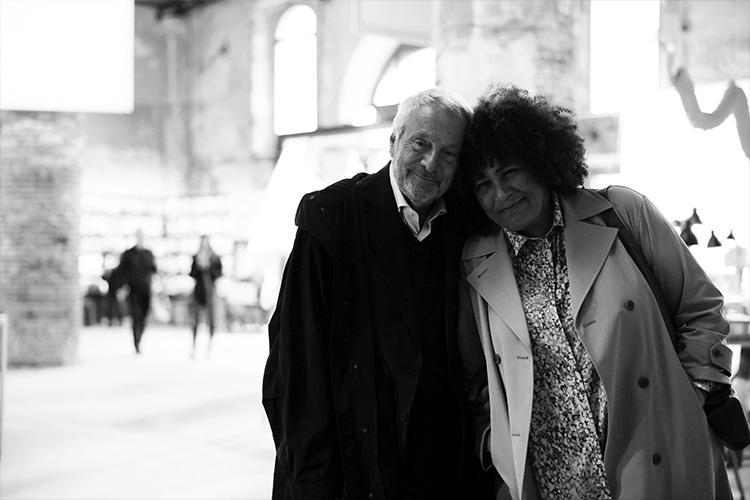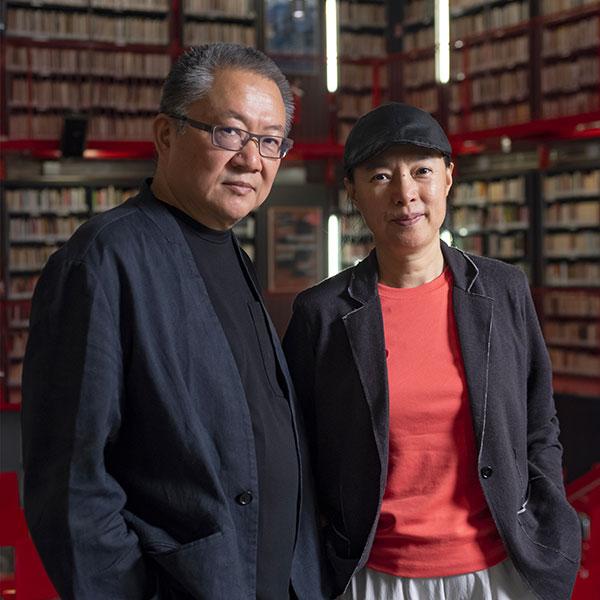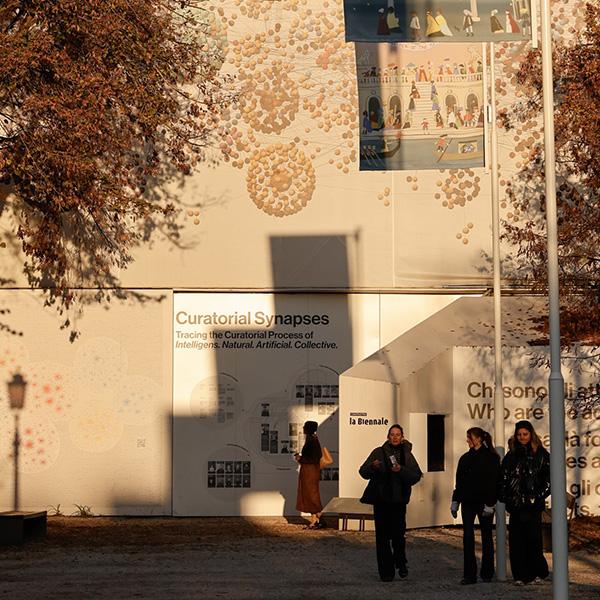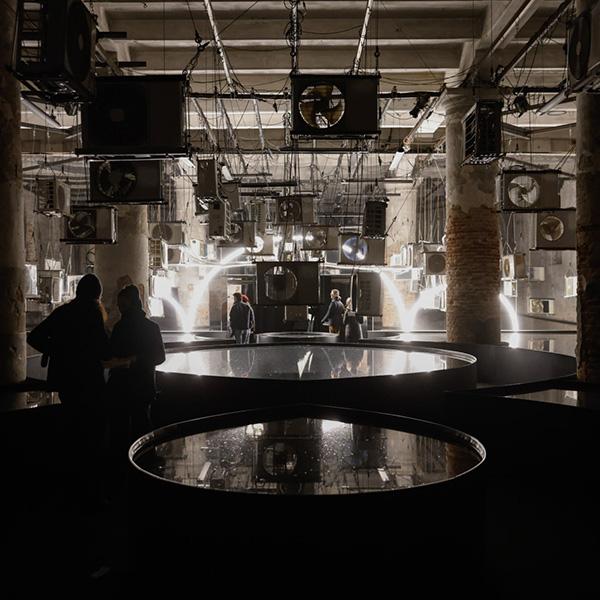
Biennale Architettura 2023: The Laboratory of the Future
The 18th International Architecture Exhibition, curated by Lesley Lokko, is open until 26 November at the Giardini, Arsenale and Forte Marghera.
Biennale Architettura 2023
The 18th International Architecture Exhibition, titled The Laboratory of the Future, is open to the public from Saturday May 20 to Sunday November 26, 2023 at the Giardini and the Arsenale, and at Forte Marghera; it is curated by Lesley Lokko and organised by La Biennale di Venezia. The pre-opening took place on May 18 and 19, the awards ceremony and inauguration was held on Saturday 20 May 2023.
La Biennale di Venezia's commitment to climate action
La Biennale di Venezia is working concretely towards the crucial goal of fighting climate change, by promoting a more sustainable model for the design, installation and operation of all its events. In 2022 La Biennale obtained this certification for all the events it held that year. This was made possible by carefully collecting the data on the causes of CO2 emissions generated by the events themselves, and on the adoption of consequent measures. The entire process for achieving carbon neutrality, conducted in compliance with the international standard PAS2060, was certified by RINA.
For all the events, the most important component of the overall carbon footprint involves the mobility of the visitors. In this sense, La Biennale will engage again in 2023 in a communication campaign to raise the awareness of the participating public, starting with the 18th International Architecture Exhibition, which will be the first major exhibition in this discipline to test in the field the process to achieve carbon neutrality, while furthermore reflecting upon the themes of decolonisation and decarbonisation.
The International Exhibition as an agent of change
“What does it mean to be ‘an agent of change’? (…) Over the past nine months, in hundreds of conversations, text messages, Zoom calls and meetings - stated Lesley Lokko - the question of whether exhibitions of this scale — both in terms of carbon and cost — are justified, has surfaced time and again. In May last year, I referred to the exhibition several times as ‘a story’, a narrative unfolding in space. Today, my understanding has changed. An architecture exhibition is both a moment and a process. It borrows its structure and format from art exhibitions, but it differs from art in critical ways which often go unnoticed. Aside from the desire to tell a story, questions of production, resources and representation are central to the way an architecture exhibition comes into the world, yet are rarely acknowledged or discussed. From the outset, it was clear that the essential gesture of The Laboratory of the Future would be ‘change’.”
“(…) For the first time ever, the spotlight has fallen on Africa and the African Diaspora, that fluid and enmeshed culture of people of African descent that now straddles the globe. What do we wish to say? How will what we say change anything? And, perhaps most importantly of all, how will what we say interact with and infuse what ‘others’ say, so that the exhibition is not a single story, but multiple stories that reflect the vexing, gorgeous kaleidoscope of ideas, contexts, aspirations, and meanings that is every voice responding to the issues of its time?”
“It is often said that culture is the sum total of the stories we tell ourselves, about ourselves. Whilst it is true, what is missing in the statement is any acknowledgement of who the ‘we’ in question is. In architecture particularly, the dominant voice has historically been a singular, exclusive voice, whose reach and power ignores huge swathes of humanity — financially, creatively, conceptually — as though we have been listening and speaking in one tongue only. The ‘story’ of architecture is therefore incomplete. Not wrong, but incomplete. It is in this context particularly that exhibitions matter”.
Exhibition structure
“The Laboratory of the Future is an exhibition in six parts. It includes 89 participants, over half of whom are from Africa or the African Diaspora. The gender balance is 50/50, and the average age of all participants is 43, dropping to 37 in the Curator’s Special Projects, where the youngest is 24. 46% of participants count education as a form of practice, and, for the first time ever, nearly half of participants are from sole or individual practices of five people or less. Across all the parts of The Laboratory of the Future, over 70% of exhibits are by practices run by an individual or a very small team. (…)”
“Central to all the projects is the primacy and potency of one tool: the imagination - Lokko said. It is impossible to build a better world if one cannot first imagine it. The Laboratory of the Future begins in the Central Pavilion in the Giardini, where 16 practices who represent a distilled force majeure of African and Diasporic architectural production have been gathered. It moves to the Arsenale complex, where participants in the Dangerous Liaisons section – also represented in Forte Marghera in Mestre - rub shoulders with the Curator’s Special Projects, for the first time a category that is as large as the others. Threaded through and amongst the works in both venues are young African and Diasporan practitioners, our Guests from the Future, whose work engages directly with the twin themes of this exhibition, decolonisation and decarbonisation, providing a snapshot, a glimpse of future practices and ways of seeing and being in the world. (…) We have deliberately chosen to frame participants as ‘practitioners’ – the Curator stated – and not ‘architects’ and/or ‘urbanists’, ‘designers’, ‘landscape architects’, ‘engineers’ or ‘academics’ because it is our contention that the rich, complex conditions of both Africa and a rapidly hybridising world call for a different and broader understanding of the term ‘architect’.
Statement by President Roberto Cicutto
“When in December 2021, at my recommendation, the Board of Directors of La Biennale di Venezia approved the appointment of Lesley Lokko as the curator of the 18th International Architecture Exhibition - Roberto Cicutto, President of La Biennale di Venezia, stated - the main reason for this choice was to give the floor to a voice that came from outside the north-western world, and above all to a person who approached architecture in way that was more aligned with our times and in progression with respect to the perspective brought by Hashim Sarkis to his 17th Exhibition “How will we live together?”
I believe that the first reactions to her statements show that what has come to be the strong point of this Biennale has been understood: the possibility of listening from the inside to the many voices that come from Africa and dialogue with the rest of the world, forcing us to abandon the image of that continent and its inhabitants that we have perpetuated for centuries, of Africa viewed more as a problem (migrants, poverty, hunger, conflict…) or simply as a country that requires help. This change of perspective as we come to know a continent that is demographically the youngest on earth, and that for many countries has become a partner of equal standing for economic agreements regarding energy procurement or infrastructural investments, carries with it a significant revolution.
I remember Lesley Lokko’s emotion in hearing the decisions of the International Jury of the Art Exhibition curated by Cecilia Alemani, which brought African artists or protagonists of the diaspora onto the podium: “we finally seated at the main table” she exclaimed. Cecilia’s Exhibition had in fact validated lesser-heard voices by inviting them to participate in her Biennale. Now Lesley is the one doing the honours, and inviting the world to her Biennale Architettura. The preparation of this Exhibition has already been a laboratory of the future”.
Biennale College Architettura
For the first time ever, Biennale Architettura will include the Biennale College Architettura, which will run from 25 June to 22 July 2023. Fifteen renowned international tutors - Samia Henni, Marina Otero, Nana Biamah-Ofosu, Thireshen Govender, Lorenzo Romito, Jacopo Galli, Philippa Tumubweinee, Ngillan Gbadebo Faal, Rahesh Ram, Guillermo Fernández-Abascal, Urtzi Grau, Samir Pandya, Alice Clancy, Sarah de Villiers and Manijeh Verghese - will work with fifty students, early career practitioners and academics from around the world, selected by Lesley Lokko through an Open Call process over the four weeks of the teaching programme. At the conclusion of the Call on February 17th, 986 applications had been received.
A documentary of the educational experience will be filmed by Ángel Borrego Cubero and released in October this year. An international cast of critics will join the College in July.
Carnival
The Laboratory of the Future programme is enriched by Carnival, a six-month-long cycle of events, lectures, panel discussions, films, and performances, that explore the themes of the Biennale Architettura 2023.
“Conceived as a space of liberation rather than a spectacle or entertainment, Carnival offers a space for communication in which words, views, perspectives, and opinions are traded, heard, analysed, and remembered – Lokko said. Politicians, policymakers, poets, filmmakers, documentary makers, writers, activists, community organisers and public intellectuals will share the stage with architects, academics, and students. This public event programme is increasingly a form of architectural practice that attempts to bridge the gulf between architects and the public.”
Carnival is supported by Rolex, Exclusive Partner and Official Timepiece of the Exhibition.
National Participations
64 National Participations will organize their exhibitions in the historic Pavilions at the Giardini (27), at the Arsenale (23) and in the city centre of Venice (14). Niger participates for the first time at the Biennale Architettura; Panama participates for the first time with its own pavilion and has already participated in previous editions as part of the I.I.L.A. (Italo-Latin American International Organization).
The Holy See returns to the Biennale Architettura, participating with its own Pavilion on the Island of San Giorgio Maggiore (it participated in the Biennale Architettura for the first time in 2018).
The Italian Pavilion at the Tese delle Vergini in the Arsenale, sponsored and promoted by the Directorate-General for Contemporary Creativity of the Ministry of Culture, is curated by the Fosbury Architecture collective, consisting of Giacomo Ardesio, Alessandro Bonizzoni, Nicola Campri, Veronica Caprino, Claudia Mainardi. The title of the exhibition is SPAZIALE: Everyone Belongs to Everyone Else.
Venice Pavilion
The exhibition of the Venice Pavilion, located in the Giardini di Sant’Elena, is organized by the Municipality of Venice. Curated by Venice Collective is titled “VENETIE MML, the great view, the telling of the work”.
Collateral Events
9 Collateral Events are admitted by the Curator and promoted by non–profit national and international bodies and institutions. Organized in several locations around the city of Venice, they offer a wide range of contributions and participations that enrich the diversity of voices that characterizes the Exhibition.
Applied Arts Pavilion
La Biennale di Venezia and the Victoria and Albert Museum, London present for the seventh consecutive year the Applied Arts Pavilion Special Project (Arsenale, Sale d’Armi A) titled Tropical Modernism: Architecture and Power in West Africa, curated by Christopher Turner (V&A) with Nana Biamah-Ofosu and Bushra Mohamed (AA). The presentation is organised in collaboration with the Architectural Association (AA), London and the Kwame Nkrumah University of Science and Technology (KNUST), Kumasi.
The International Jury
The International Jury of the 18th International Architecture Exhibition 2023 - deliberated by the Board of Directors of La Biennale di Venezia upon recommendation by Lesley Lokko - is made up of the Italian architect and curator Ippolito Pestellini Laparelli (president); the Palestinian architect and curator, Nora Akawi; the American director and curator of The Studio Museum in Harlem, Thelma Golden; the Zimbabwean founder and co-editor of Cityscapes Magazine, Tau Tavengwa; the Polish architect, researcher and educator Izabela Wieczorek.
The International Jury will award the following official prizes: Golden Lion for best National Participation, Golden Lion for best participant and Silver Lion for a promising young participant in the International Exhibition The Laboratory of the Future.
The Golden Lion for Lifetime Achievement will be awarded to Demas Nwoko, Nigerian born artist, designer and architect, during the Biennale Architettura 2023 awards and inauguration ceremony, that will be held on Saturday 20th May, 2023 at Ca’ Giustinian, the headquarters of La Biennale di Venezia.
Biennale Sessions
The project for universities
La Biennale dedicates the Biennale Sessions project to Universities, Academies of Fine Arts, and other Institutes of Higher Learning. The aim is to facilitate three-day self-organized visits by groups of at least 50 students and teachers, offering assistance in the organization of travel and accommodations and the possibility of organizing seminars in exhibition venues free of charge.
Educational
For the past decade, La Biennale di Venezia has been devoting increased attention to learning activities and has developed a growing commitment to educational initiatives addressed to the audience of its Exhibitions, to universities, young people, and children, from schools at all levels. In the past two years, Biennale Architettura 2021 and Biennale Arte 2022 counted 111,164 participants in Education activities, of which 52,392 were young people. A broad Educational programme will be offered in 2023 as well, addressed to individuals and groups of students, children, adults, families, professionals, companies, and universities. All these initiatives aim to actively involve participants. They are conducted by professional operators, carefully trained by La Biennale, and they fall under the following categories: Guided Itineraries and Workshop Activities and Interactive Initiatives.
Editorial project and graphic identity
The official catalogue, titled The Laboratory of the Future, consists of two volumes.
Volume I is divided into different sections dedicated to the events of Carnival and to the Curator’s Special Projects. Two sections are dedicated to the International Exhibition curated by Lesley Lokko, respectively titled Force Majeure and Dangerous Liaisons. Each project on display in the Exhibition is accompanied by a critical text and a rich iconography that completes the Participants’ work. A further section is dedicated to the first edition of the Biennale College Architettura. Embedded throughout are a series of essays developing the themes of the Exhibition and a detailed record of the works on display.
Volume II presents the National Participations and the Collateral Events. It includes a series of illustrated texts that delve deeper into the projects on exhibit in the Pavilions and the Collateral Events at the Giardini, at the Arsenale and in various locations across Venice.
The graphic identity of the Biennale Architettura 2023 and the design of the publications are the work of Die Ateljee – Fred Swart. The volumes are published by Edizioni La Biennale di Venezia.
Partner and sponsors
The Biennale Architettura 2023 has been made possible by the support of Rolex, Partner and Official Timepiece of the event.
We would like to thank the Sponsors of the Biennale Architettura 2023: Bloomberg Philanthropies with Bloomberg Connects, Vela-Venezia Unica and Zafferano.
We would also like to thank Cleary Gottlieb Steen & Hamilton LLP.
Rai is Media Partner of the 18th International Architecture Exhibition and will follows the event with a dedicated offer on TV, radio and on the web.
Acknowledgements
We would like to thank the Ministry of Culture, the local institutions that support La Biennale in various ways, the City of Venice, the Veneto Region, the Soprintendenza Archeologia, Belle Arti e Paesaggio per il Comune di Venezia e Laguna, and the Italian Navy.
We thank the important international Donors, organisations and institutions who have contributed to the success of the Biennale Architettura 2023.
Our warmest thanks go to Lesley Lokko and her entire team.
Finally, we would also like thank everyone at La Biennale for the great professionalism and dedication they have demonstrated in the realisation and administration of the Exhibition.




